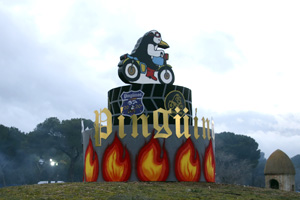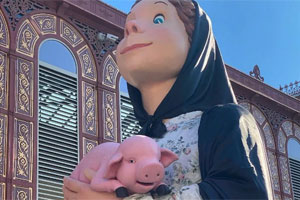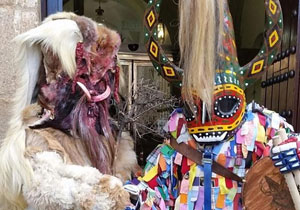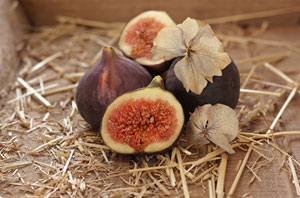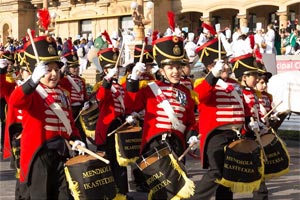Yeguas Round-up in Almonte
What does the Saca de Yeguas consist of?
The traditional "Saca de Yeguas" is a livestock event that takes place annually in Almonte, a municipality in the province of Huelva, Andalusia. It is a remarkable spectacle where horses and mares that have been raised in the Doñana marshes throughout the year are rounded up. These animals, which have lived freely and in contact with nature, are brought to the village of El Rocío, belonging to the municipality of Almonte.
This ancient tradition, regulated in 1504 by an ordinance of the Duke of Medina Sidonia, takes place at the end of June, coinciding with the Feria de San Pedro, the patron saint of the municipality.
During the "saca," the "yegüerizos," the caretakers of the mares, travel through different areas of the Doñana marshes, such as La Marismilla, Las Nuevas, el Rincón del Pescador, la Vuelta de la Madre, Matasgorda, El Lobo, Las Mogeas, and el Lucio de las Yeguas, to gather the livestock on the beach in front of El Rocío. From there, on June 26th, they head towards Almonte, passing through the village of El Rocío, where the mares and the yegüerizos receive the blessing from the priest of the Hermitage before continuing their journey to Almonte.
Upon reaching the Santa María stream near Los Olivarejos, they take a moment to rest and then form groups to enter the town. Once in Almonte, the mares parade through the streets until they reach an enclosure where they will stay for about five days. During this time, various tasks are carried out, such as trimming their hair, deworming, and branding the young mares, to prepare them for sale. Both the entry of the mares into the town and their stay there attract the attention of numerous people. After a few days, the mares are returned to the marshes, where they will remain until the following June.
It is interesting to note that Almonte is twinned with La Estrada, a Galician town that also has a similar equine tradition called "Rapa das bestas," which you can also learn about on fiestapopular.com.
The "Saca de Yeguas" is a significant event for the culture and economy of the region, as horse breeding and sales are a traditional economic activity in Almonte and its surroundings. It is a unique tradition that showcases the close relationship between the local inhabitants and the Doñana marshes. It is an event filled with excitement, beauty, and equestrian skill that attracts numerous visitors and horse enthusiasts every year.
What to see in Almonte
Almonte is a beautiful town located in the province of Huelva. Here are some recommendations on what to see in Almonte:
- Nuestra Señora del Rocío Sanctuary: The main attraction in Almonte is the famous Sanctuary of the Virgin of El Rocío, a highly important pilgrimage site in Spain. You can visit the hermitage and enjoy the beauty of the surrounding area.
- Doñana National Park: Almonte is located at the doorstep of Doñana National Park, a protected natural treasure. You can take excursions to observe the unique flora and fauna of the area, such as migratory birds, deer, and Iberian lynxes.
- Church of the Assumption: This church is one of the main landmarks in Almonte. It dates back to the 15th century and features Gothic-Mudéjar architectural style.
- Villa Museum: In the center of Almonte, you can visit the Villa Museum, which displays exhibitions related to the history, culture, and traditions of the region.
- Coto de Doñana Interpretation Center: This center provides detailed information about Doñana National Park and its ecosystem. You can learn about the flora and fauna of the area and the importance of its conservation.
- Stroll through the historic center: Explore the streets of Almonte's old town and discover the typical Andalusian architecture, with whitewashed houses and flower-filled inner courtyards.
These are just some suggestions, but Almonte and its surroundings have much more to offer. Enjoy its natural and cultural charm as you explore the area.
What to eat in Almonte
The typical and popular cuisine of Almonte is influenced by the culinary tradition of the province of Huelva and Andalusian cuisine. Some dishes and products we can recommend are:
- Iberian ham: Almonte is located in an area known for the production of high-quality Iberian ham. Try this exquisite delicacy, whether in slices with a good cut or as part of other dishes.
- Huelva prawns: The proximity of Almonte to the coast provides access to delicious Huelva prawns, fresh and flavorful seafood that can be enjoyed grilled, in rice dishes, or in stews.
- Fried cuttlefish: This typical regional dish consists of small and tender fried squid with a crispy coating. It is a delight that can be enjoyed as a tapa or main course.
- Coquinas: Coquinas are small mollusks found on the coasts of Huelva. They are prepared in a pan with garlic, parsley, and a touch of lemon, making them a popular choice as a tapa.
- Miga: Miga is a traditional dish in Almonte and the region, made from bread soaked in fish or meat broth, seasoned with spices, and accompanied by ingredients such as egg, ham, or chorizo.
- Eggplants with honey: This combination of fried eggplants and honey is a typical delight of the region. The eggplants are thinly sliced, fried, and served with a drizzle of honey on top.
- Goat cheese: Livestock farming is important in the area, and delicious artisanal goat cheese with a distinctive flavor is produced. You can enjoy it on its own, in salads, or as part of a cheese platter.
- Regional wines: Huelva has wineries that produce quality wines, such as white and red wines with the designation of origin "Condado de Huelva." Accompany your meals with a glass of local wine.
These are just some examples of the typical and popular gastronomy of Almonte. The region offers a wide variety of flavors and traditional dishes that reflect the culinary richness of Andalusia.

